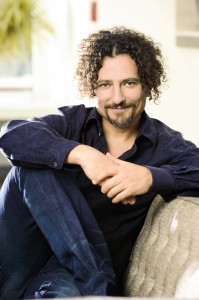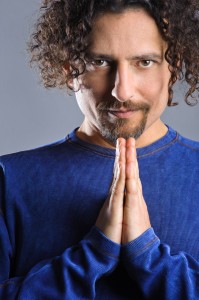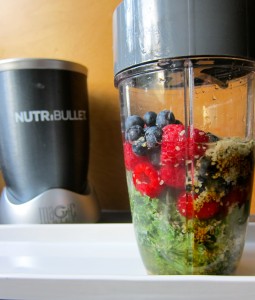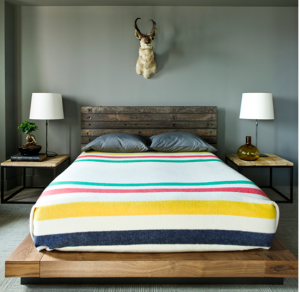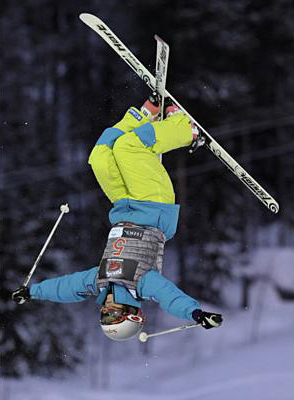*This article first appeared in the Montreal Gazette, and then went viral online at Canadian Postmedia newspapers including the Vancouver Sun, Calgary Herald, Edmonton Journal, etc.
Here’s a little something for the fellas. This fall I was inspired by the new Americana or Heritage look for men and wrote about it on three separate occasions (one’s on ties, another on man bags, and the last is a Q&A with two store owners). I think it’s a great, cozy style, esp. when pulled off correctly!
These mini articles are different from the long, feature stories I typically post on this website — which, btw, is a forum to showcase my work, not to reprint every single article I write in the earnest ambitions of getting sued! (If you wanna read my shorter articles on a regular basis, please Google!!). Thanks for understanding, kind reader.
It’s Dave’s cousin Gilad (hence the giant photo)! He’s modeling for new online tie company Dolbeau.ca. Note the man-bag too, which is article #2 in this man fashion article trio.
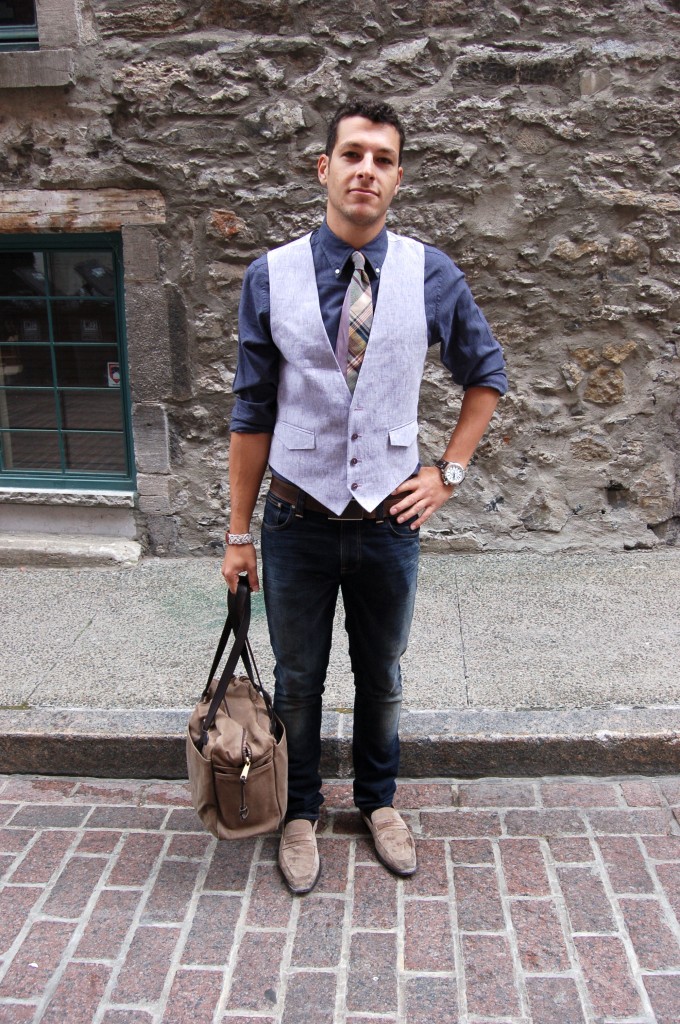
MEN OF TIES, Part 1 of new Americana Men’s Fashion
A slightly dishevelled dapper look is all the rage these days in menswear, according to David Caplan and David Gross.
Citing what’s in this fall, the founders of Dolbeau.ca, a new online custom neckwear company based in Montreal, say keep the jeans and button down, throw on a cozy sweater or blazer, but add a personalized flare -say a floral themed bow tie or perhaps a plaid woolly skinny tie.
“In Montreal, it’s not usual yet, but in Toronto bow ties are becoming more popular,” says Caplan, sporting a bow tie himself. “I wear it everywhere,” he says.
“In Scandinavia and Italy, they’re popular also,” says Gross, wearing one of his custom designed solid ties.
Gross was inspired to launch Dolbeau.ca, named after his grandmother’s street in Outremont, after reading men’s fashion blogs like valetmag.com, getkempt.com, streetpeeper.com and thesartortialist.blogspot.com. He says these blogs, not the runway shows, are dictating fashion today.
“Men are looking for special accessories,” Gross says, and the “workingman Americana” look is the prominent style.
“Bow ties or ties are a great way of expressing yourself and standing out,” he adds.
To keep the look unique, all Dolbeau.caties are custom made.
They’re sewn here in Montreal with the fabric imported from such countries as Germany, Italy, France and the United States.
Customers choose their own two-tone pattern, width, tip and tie length (shorter for petite fellows and longer for taller gents or those with large necks).
“We’re catering to people who know their own taste,” Gross says. “It’s a one of a kind piece for a one of a kind person.”
Custom ties are $119, and bow ties are $89, both plus tax in Quebec, and available for purchase on Dolbeau.ca.
A customized line by boutique Rooney, which includes solid-coloured narrow wool ties and diamond tip bow ties, is available at Rooney on 395 Notre Dame St. W. in Old Montreal and rooneyshop.com.

One of the Dolbeau.ca founders David Caplan.
Man Bags All The Rage, Part 2 of New Americana Men’s Fashion
Scott (the Sartorialist) Schuman helped to raise the mystique of WANT Les Essentiels de la Vie bags, founded by Montrealers Dexter and Byron Peart, by last year featuring the brand in the SartoriaLUST pop-up shop at Barneys New York. These days, men of all types, not just street-style photographers, are coveting a good bag to lug around their gadgets.
“Men are constantly travelling with smart phones, iPads, iPods, keys, wallets, pens, passports, etc.,” Dexter Peart said. “There’s a legitimate need for small bags that offer the same function as a lady’s purse, (but) something that retains a certain masculinity.”
So call it a man bag, a “murse” or even just a bag. Just make sure it serves several purposes.
According to the Peart bothers, their O’Hare tote, which comes in leather or organic cotton, is a hit because it has a minimalist design and can be used for multiple purposes.
Still, they agree that most men need four bags: a computer bag, a shoulder bag/ knapsack, an overnight bag and a tote.
“We try to create products that adapt to the contrasting environment that we live in,” Byron Peart said.

A Filson briefcase from ronneyshop.com. See interview below.
Q&A with owners of Boutique Rooney
Alex Danino and Michelle Golfman, who are husband and wife, own Rooney, a men’s and women’s clothing boutique at 395 Notre Dame St. W. in Old Montreal. Next to the shop’s ever-fashionable women’s tops and sweaters, there is a “well curated” assortment of Americana men’s fashion. 514-543-6234. www.rooneyshop.com.
How did you come up with the store’s concept -or, first of all, what would you call the store’s concept?
Alex: Well, it’s a unisex store, and, at this moment, it’s probably split 60 per cent on the men’s side and 40 per cent on the women’s. It’s becoming a bit more of a lifestyle shop, too, with a variety of interesting things that all go toward the same aesthetic, really, be it through books or accessories or whatever. But you asked what the concept is, right?
Yep.
Alex: Well, the aesthetic is my own personal evolution. Initially when we opened the store (five years ago), it was more of a streetwear –
Michelle: Younger.
Alex: Yeah, younger and the commodities were a bit more affordable. There were more T-shirts, hoodies, button-downs and denim. Footwear was more on the sneaker side. Then I turned 30 and then I was sort of like, ‘you know what? I want to get into more of a mature feel.’
So, how are the clothes different now?
Alex: I got into more formal footwear, more like an Oxford-style. And then the brands that I was personally starting to be passionate about, a lot of them are starting to manufacture in North America or sourcing fabrics from Italy and Portugal, so the prices went up, too. But that’s not every product -there’s a real mix. I don’t want button-downs to be above $200. We try to make it affordable. We even have button-downs starting at $70.
I see a lot of plaid button-downs here. How is a $200 plaid shirt here different than one, say, at H&M for about $20?
Alex: Well, you know, they cut corners. They offer a product for really, really cheap and they save money because they need to cut corners somewhere.
Michelle: And they sell to mass.
Alex: Yeah, and so there are two things. You end up with a product that’s not going to last you and then you end up with a product that maybe every one of your friends is going to be in. Although the second part might not be as important, I think the first part is because you’ll end up with a product that will probably fall apart.
And how long should a plaid shirt from here last?
Alex: Well, I mean, hopefully, maybe 10 years, maybe more. And a lot of these products get better with age. Like some of the fabrics they’re using are wax cottons, canvas, denim -and they age well. They get these patinas when you wear them. If you have a wallet in a certain position or if you have something always there like keys, you have your own personal wear, which is kind of cool.
So, it’s a preppy, over-30, worn patina look -is that the style you’re now selling?
Alex: I guess you could call preppy, or you could call it Americana or even Canadiana, like local stuff that’s made in the U.S. or Canada. Also, there’s a resurgence in heritage brands that have actually been around for over 100 years, like woollen products from Pendleton and Woolrich. Then there’s Filson and Red Wing boots that still make the same products. The overall aesthetic is influencing a lot of the new designers, too.
How does a guy wear these heritage products in a modern style, though? Like, right there I see plaid flannel shirt. I mean, what do you call that style of plaid again?
Alex: Blanket check.
Right. So, on the mannequin you’ve put a blanket check button-down shirt, with a tie and an over-sweater: What’s that look about?
Alex: It’s the prints, the patterns, the fabrics that are blended together. It’s not just a white shirt with a black blazer and a black tie. This is texture, which is cool. Because there’s like flannel with a pattern and then the thicker woolly texture. And then you have a tie with its own really interesting weave. So, together you’ve got more of an outdoorsy feel as opposed to something that, say, a banker or an accountant might wear.
Where would a guy wear that kind of outfit?
Alex: To be honest, anywhere and always. I see a guy walking out of his house, you know, or if you’re working in a creative field from marketing to advertising to an Internet company. And it’s cool to see because it’s been a good response. People even younger than guys in their 30s are taking this kind of trend into their lives. Guys as young as high school.
We even sell this book that was a reissue from the 1960s.
I see: Take Ivy, by Teruyoshi Hayashida.
Alex: Yeah, it was made in 1965 by a Japanese photographer and all these images are Ivy League campuses in the ’60s and the fashion is exactly the same today. The things they’re wearing (points to a picture of check Bermuda shorts) are exactly what I sold this summer. It’s really kind of interesting how it’s come full circle, though in more slightly updated ways.
What are some of those updates?
Alex: They’re less boxy. They’re a little more tailored and fitted. But they’ll still have some of the original features like box pleats in a shirt, or button-down collars, but at the same time more of a modern fit.
What do you think is responsible for the resurgence in this style of men’s fashion?
Alex: Good question. Obviously, it’s always been around with J. Crew and things. But now it’s become more popular starting about 31/2 years ago, where you started getting a lot of blogs who are interested in these products, and really going after these old brands. And then it started trickling into the designers.
Michelle: And then there are TV shows like Mad Men and people are wanting to bring that back.
Alex: Yeah. And even now on Boardwalk Empire they dress amazingly; all the clothing’s phenomenal.
Do your customers buy separate pieces or the entire look?
Alex: Overall, it’s the whole aesthetic, the whole package that you see all together. Like some guy in Australia bought a pair of Bass shoes on our online shop, which is an old company that’s easy to find, but it was just packaged on my website. So this guy got a blazer from Our Legacy, a pair of shoes from Bass, I think maybe a book also.
What’s your average customer like?
Alex: Anywhere from 20 to 40. There’s a good section of tourists who come through and then there are a lot of locals. We also have people coming back from Toronto and New York who go on these foodie-type trips.
So your heritage clothes are on the upswing with local gourmand cuisine?
Alex: Yeah, except sadly, there aren’t a lot of Montreal or Canadiana heritage brands. We carry Naked and Famous from Montreal, who do quite well –
Michelle: Otherwise, there’s a mixture of American, Swedish, British …
You’ve described your store as “well-curated” before. What do you mean by that?
Alex: That I take an obscene amount of time to research some of the products. It’s all I do and I love doing it. So, it’s really my passion. I spend all day long looking at products, blogs, seeing what people are doing out there. I look at everything.
Michelle: And all night. All day, all night -it’s true.
Alex: We always focus on the quality of the product, and backstory is important. I want to tell customers where the product is from, who the designer is, so they can walk away knowing what they just bought.
Michelle: It’s that or H&M. Alex: And guys want product. They want product that can last, that are made by hand. That’s what this store is about. It’s not to say that China doesn’t make good product -we sell product made in China, they’re known for knit and they have some of the best machinery -it’s just that the English mill worker has history. They’ve been doing it for 150 years. Wax cotton is part of their tradition. If you wanna get the best product, you have to ask ‘where is it from?’ and ‘where did it originate?’
